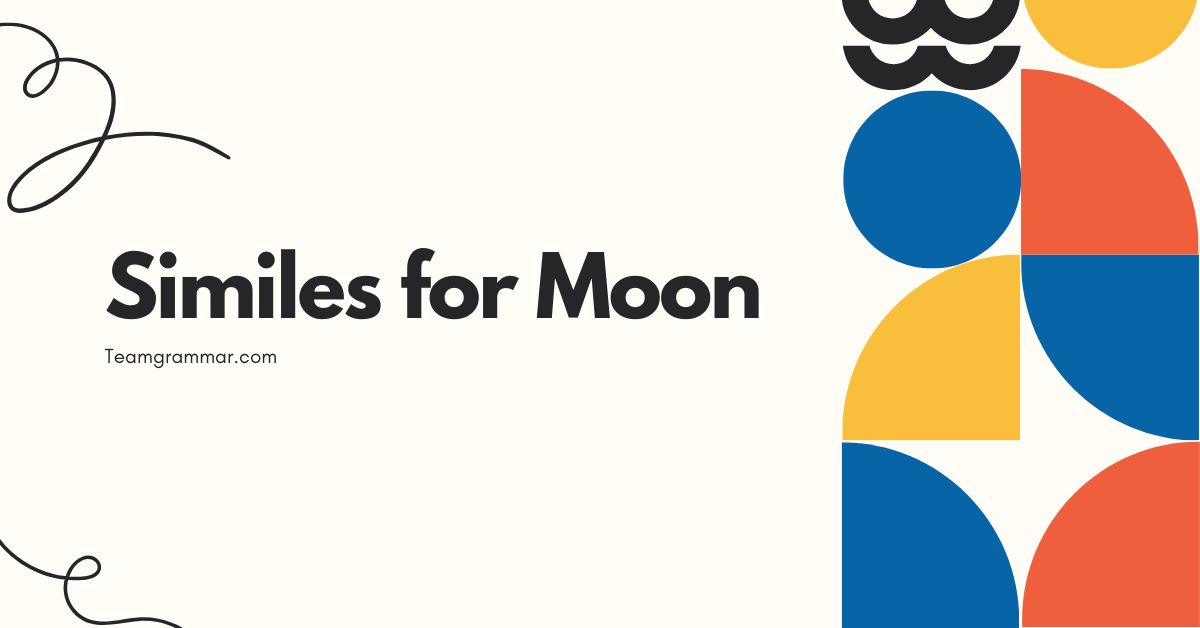29 Similes for the Moon: Mastering Figurative Language
Understanding similes is essential for enhancing your descriptive writing and comprehension skills. Similes allow us to create vivid comparisons, making our language more engaging and expressive.
This article focuses specifically on similes related to the moon, providing a comprehensive guide suitable for English language learners, creative writers, and anyone looking to enrich their vocabulary. By exploring various examples and usage rules, you’ll learn how to effectively use similes to evoke imagery and convey deeper meaning.
Table of Contents
- Introduction
- Definition of Simile
- Structural Breakdown of Similes
- Types of Similes
- Examples of Similes for the Moon
- Usage Rules for Similes
- Common Mistakes with Similes
- Practice Exercises
- Advanced Topics in Similes
- Frequently Asked Questions
- Conclusion
Definition of Simile
A simile is a figure of speech that directly compares two different things using the words “like” or “as.” The purpose of a simile is to describe something by likening it to something else that shares a similar quality or characteristic. Similes help to create vivid images and enhance understanding by drawing connections between familiar and unfamiliar concepts.
They are a fundamental tool in descriptive writing and poetry, allowing writers to evoke emotions and paint detailed pictures with words.
Similes are classified as a type of figurative language, which means they use words or expressions with a meaning that is different from the literal interpretation. The function of a simile is to make writing more engaging, descriptive, and relatable.
Similes can be used in various contexts, from everyday conversation to formal literature. They add depth and color to language, making it more appealing and memorable.
For example, “The moon was like a silver coin in the sky” uses a simile to describe the moon’s appearance by comparing it to a familiar object, a silver coin. This comparison helps the reader visualize the moon’s shape and color more effectively.
Similes are a powerful tool for writers to communicate complex ideas in a simple and understandable way.
Structural Breakdown of Similes
A simile typically consists of three main components: the subject being described, the linking word (“like” or “as”), and the object or idea to which the subject is being compared. Understanding these components is crucial for constructing effective similes.
The subject is the thing you want to describe, and the object is what you’re comparing it to. The linking word establishes the connection between the two.
The basic structure of a simile can be represented as: Subject + Linking Word + Object. For example, in the simile “The moon is like a pearl,” the subject is “the moon,” the linking word is “like,” and the object is “a pearl.” This structure provides a clear and direct comparison that enhances the reader’s understanding.
Variations in simile structure may include the use of adjectives or adverbs to further refine the comparison. For instance, “The moon shone as brightly as a diamond” includes the adverb “brightly” to emphasize the intensity of the moon’s light.
These variations allow for more nuanced and precise comparisons, adding layers of detail to the description.
Types of Similes
While all similes use “like” or “as” to draw a comparison, they can be categorized based on the specific qualities or characteristics they emphasize. Understanding these categories can help you create more targeted and effective similes.
Here are some common types of similes:
Descriptive Similes
Descriptive similes focus on physical attributes or qualities. They paint a picture by comparing the subject to something that shares similar visual, tactile, or auditory characteristics.
For example, “The moon was as white as snow” is a descriptive simile that emphasizes the moon’s color.
Comparative Similes
Comparative similes highlight similarities in behavior, function, or effect. They illustrate how the subject and the object of comparison share similar actions or outcomes.
For example, “The moon pulls the tides like a magnet pulls iron” is a comparative simile that demonstrates the moon’s gravitational influence.
Figurative Similes
Figurative similes use abstract or symbolic comparisons to convey deeper meaning or emotion. They often rely on metaphorical connections rather than literal similarities.
For example, “The moon is like a silent guardian watching over the earth” is a figurative simile that evokes a sense of protection and vigilance.
Examples of Similes for the Moon
Similes can be used to describe various aspects of the moon, including its appearance, brightness, shape, texture, and movement. The following sections provide examples of similes categorized by these different characteristics.
Appearance
Similes describing the moon’s appearance often focus on its color, size, and overall visual impression. These similes help to create a vivid mental image of the moon’s beauty and allure.
The table below provides 30 examples of similes describing the moon’s appearance.
| Simile | Explanation |
|---|---|
| The moon was like a silver coin in the sky. | Compares the moon to a shiny, circular object. |
| The moon was as white as a pearl. | Emphasizes the moon’s luminous, pale color. |
| The moon was like a ghostly face peering down. | Evokes a sense of mystery and ethereal presence. |
| The moon hung in the sky like a lantern. | Highlights the moon’s illuminating quality. |
| The moon was as round as a dinner plate. | Illustrates the moon’s circular shape. |
| The moon was like a spotlight on the world. | Emphasizes the moon’s role in lighting up the night. |
| The moon was as pale as a ghost. | Compares the moon’s color to the spectral appearance of a ghost. |
| The moon was like a distant memory in the sky. | Evokes a sense of nostalgia and remoteness. |
| The moon shone like a beacon in the darkness. | Highlights the moon’s guiding light. |
| The moon was as big as a beach ball. | Provides a relatable comparison for the moon’s apparent size. |
| The moon was like a celestial eye watching over us. | Evokes a sense of protection and observation. |
| The moon was as golden as honey. | Emphasizes the moon’s warm, yellowish glow. |
| The moon was like a slice of lemon in the night. | Highlights the crescent shape of the moon. |
| The moon shone as softly as a candle flame. | Emphasizes the gentle illumination of the moon. |
| The moon was like a broken mirror reflecting the sun. | Evokes a sense of fragmentation and reflected light. |
| The moon was as silver as mercury. | Compares the moon’s color to the shiny, metallic appearance of mercury. |
| The moon was like a pearl in an ink-black sea. | Highlights the contrast between the moon and the dark sky. |
| The moon was as luminous as a firefly. | Emphasizes the moon’s glowing quality. |
| The moon was like a silent sentinel guarding the night. | Evokes a sense of vigilance and protection. |
| The moon was as cold as ice. | Compares the moon’s appearance to the frigid nature of ice. |
| The moon was like a chalk drawing on a blackboard sky. | Highlights the moon’s pale appearance against the dark sky. |
| The moon was as bright as a newborn star. | Emphasizes the moon’s radiant glow. |
| The moon was like a cosmic clock in the heavens. | Evokes a sense of time and celestial order. |
| The moon shone as serenely as a sleeping child. | Emphasizes the peaceful nature of the moon’s light. |
| The moon was like a ghostly ship sailing through the sky. | Evokes a sense of mystery and ethereal movement. |
| The moon was as round and full as a ripe fruit. | Compares the moon’s shape to the fullness of ripe fruit. |
| The moon was like a shimmering jewel in the dark velvet of night. | Highlights the moon’s precious and radiant appearance. |
| The moon was as constant as the tides it commands. | Emphasizes the moon’s reliable and unwavering presence. |
| The moon was like a watchful eye in the inky sky. | Evokes a sense of vigilance and silent observation. |
| The moon was as smooth as polished stone. | Compares the moon’s apparent surface to the texture of polished stone. |
Brightness
Similes describing the moon’s brightness often compare it to other sources of light, such as stars, lamps, or flames. These similes emphasize the moon’s ability to illuminate the night sky.
The table below provides 30 examples of similes describing the moon’s brightness.
| Simile | Explanation |
|---|---|
| The moon shone as brightly as a diamond. | Compares the moon’s brilliance to the sparkle of a diamond. |
| The moon was like a spotlight in the night sky. | Emphasizes the moon’s focused and intense light. |
| The moon was as radiant as a star. | Highlights the moon’s luminous and shining quality. |
| The moon shone like a lamp in the heavens. | Compares the moon’s light to a comforting and familiar source. |
| The moon was as bright as a flashlight. | Provides a relatable comparison for the moon’s illumination. |
| The moon was like a beacon guiding ships at sea. | Emphasizes the moon’s role in providing direction and safety. |
| The moon shone as intensely as a burning flame. | Compares the moon’s brightness to the intensity of fire. |
| The moon was like a celestial lighthouse in the sky. | Highlights the moon’s guiding and protective light. |
| The moon was as luminous as a glowworm. | Emphasizes the moon’s subtle and gentle glow. |
| The moon shone like a mirror reflecting the sun’s light. | Compares the moon’s brightness to reflected sunlight. |
| The moon was as radiant as a halo. | Evokes a sense of divine and ethereal light. |
| The moon shone like a polished silver shield. | Highlights the moon’s reflective and protective qualities. |
| The moon was as bright as a streetlamp. | Provides a familiar comparison for the moon’s illumination. |
| The moon shone like a celestial candle. | Compares the moon’s light to a gentle and comforting flame. |
| The moon was as radiant as a sunrise. | Highlights the moon’s ability to bring light to the darkness. |
| The moon shone like a burst of starlight. | Emphasizes the moon’s sudden and brilliant appearance. |
| The moon was like a celestial firefly dancing in the sky. | Evokes a sense of playful and enchanting light. |
| The moon was as bright as a magnesium flare. | Compares the moon’s intensity to a powerful and sudden light. |
| The moon shone like a cosmic searchlight. | Highlights the moon’s ability to illuminate the vastness of space. |
| The moon was as luminous as a pearl necklace. | Emphasizes the moon’s gentle and radiant glow. |
| The moon shone like a celestial spotlight on a stage. | Highlights the moon’s dramatic and illuminating presence. |
| The moon was as bright as a distant planet. | Compares the moon’s luminosity to the light of other celestial bodies. |
| The moon shone like a cosmic ember in the night. | Evokes a sense of warmth and lingering light. |
| The moon was as radiant as a summer sun. | Emphasizes the moon’s powerful and life-giving light. |
| The moon shone like a celestial jewel in the sky. | Highlights the moon’s precious and radiant appearance. |
| The moon was as bright as a welder’s torch. | Compares the moon’s intensity to a powerful and focused light source. |
| The moon shone like a cosmic flashlight in the darkness. | Emphasizes the moon’s ability to illuminate and guide. |
| The moon was as luminous as a firework display. | Highlights the moon’s spectacular and radiant glow. |
| The moon shone like a celestial lantern lighting our way. | Evokes a sense of guidance and illumination. |
| The moon was as bright as a distant sun. | Compares the moon’s luminosity to the power of the sun. |
Shape
Similes describing the moon’s shape often focus on its various phases, from crescent to full. These similes help to illustrate the changing appearance of the moon throughout the lunar cycle.
The table below provides 25 examples of similes describing the moon’s shape.
| Simile | Explanation |
|---|---|
| The moon was as round as a pie. | Compares the moon’s full shape to a circular pie. |
| The crescent moon was like a fingernail clipping in the sky. | Highlights the thin, curved shape of the crescent moon. |
| The full moon was like a giant eye staring down at the earth. | Evokes a sense of observation and completeness. |
| The moon was as curved as a banana. | Compares the moon’s crescent shape to the curve of a banana. |
| The moon was like a silver sickle hanging in the sky. | Highlights the sharp, curved shape of the crescent moon. |
| The moon was as full as a balloon about to burst. | Emphasizes the round and swollen appearance of the full moon. |
| The crescent moon was like a smile in the night. | Evokes a sense of joy and gentle presence. |
| The moon was as round as a beach ball. | Provides a relatable comparison for the moon’s full shape. |
| The moon was like a slice of orange in the sky. | Highlights the curved and segmented shape of the crescent moon. |
| The moon was as round as a perfectly drawn circle. | Emphasizes the perfect circularity of the full moon. |
| The crescent moon was like a sliver of soap. | Highlights the thin, curved shape of the crescent moon. |
| The moon was as full as a pregnant belly. | Emphasizes the round and swollen appearance of the full moon. |
| The moon was like a curved blade in the dark sky. | Highlights the sharp, curved shape of the crescent moon. |
| The moon was as round as a polished globe. | Compares the moon’s full shape to a perfectly round globe. |
| The crescent moon was like a comma in the sentence of the night. | Evokes a sense of pause and transition. |
| The moon was as round as a silver dollar. | Compares the moon’s full shape to a circular coin. |
| The crescent moon was like a curved eyebrow in the sky. | Highlights the arching shape of the crescent moon. |
| The moon was as full as a harvest moon. | Emphasizes the abundant and complete appearance of the full moon. |
| The moon was like a broken plate in the dark expanse. | Highlights the imperfect or incomplete shape of the moon. |
| The moon was as round as a watchful eye. | Evokes a sense of vigilance and completeness. |
| The crescent moon was like a gently curved cradle. | Highlights the comforting and protective shape. |
| The moon was as full as a drum. | Compares the moon’s full shape to a round, resonant drum. |
| The moon was like a half-eaten cookie in the sky. | Highlights the partially illuminated shape. |
| The moon was as round as a mirror reflecting back the night. | Emphasizes the completeness of the full moon. |
| The crescent moon was like a smile from the heavens. | Evokes a sense of joy and gentle presence. |
Texture
Similes describing the moon’s texture often focus on its apparent surface qualities, such as smoothness, roughness, or cratered appearance. These similes help to convey the moon’s physical characteristics.
The table below provides 20 examples of similes describing the moon’s texture.
| Simile | Explanation |
|---|---|
| The moon’s surface was like a bumpy golf ball. | Compares the moon’s uneven surface to the texture of a golf ball. |
| The moon was as smooth as polished marble. | Emphasizes the moon’s seemingly flawless surface. |
| The moon’s craters looked like pockmarks on a face. | Highlights the moon’s scarred and uneven texture. |
| The moon was like a cheese grater, full of holes and ridges. | Compares the moon’s surface to a rough and textured kitchen tool. |
| The moon was as rough as sandpaper. | Emphasizes the moon’s abrasive and uneven texture. |
| The moon’s surface was like a sponge, full of tiny pores. | Highlights the moon’s porous and absorbent texture. |
| The moon was as smooth as a baby’s skin. | Compares the moon’s surface to the soft and delicate texture of a baby’s skin. |
| The moon’s texture was like a relief map, with mountains and valleys. | Highlights the moon’s varied and uneven terrain. |
| The moon was as bumpy as a dirt road. | Emphasizes the moon’s uneven and rugged surface. |
| The moon’s surface was like a dried riverbed, cracked and parched. | Compares the moon’s texture to a dry and desolate landscape. |
| The moon was as smooth as a still lake. | Emphasizes the moon’s seemingly calm and undisturbed surface. |
| The moon’s texture was like a lunar fingerprint, unique and complex. | Highlights the moon’s distinctive and individual characteristics. |
| The moon was as rough as a weathered stone. | Compares the moon’s surface to the rugged and aged texture of stone. |
| The moon’s surface was like a canvas painted with shadows and light. | Highlights the moon’s artistic and textured appearance. |
| The moon was as bumpy as a cobblestone street. | Emphasizes the moon’s uneven and irregular surface. |
| The moon’s texture was like a lunar tapestry, woven with craters and plains. | Compares the moon’s surface to an intricate and detailed fabric. |
| The moon was as smooth as a silk cloth. | Emphasizes the moon’s seemingly soft and delicate surface. |
| The moon’s surface was like a giant puzzle, with missing pieces and hidden depths. | Highlights the moon’s mysterious and incomplete appearance. |
| The moon was as rough as a bark of a tree. | Compares the moon’s surface to the rugged and coarse texture of tree bark. |
| The moon’s texture was like a lunar mosaic, composed of various shapes and sizes. | Highlights the moon’s diverse and multifaceted composition. |
Movement
Similes describing the moon’s movement often focus on its apparent motion across the sky, its rising and setting, and its influence on the tides. These similes help to convey the moon’s dynamic presence.
The table below provides 20 examples of similes describing the moon’s movement.
| Simile | Explanation |
|---|---|
| The moon moved across the sky like a slow-motion clock hand. | Compares the moon’s gradual movement to the steady progress of a clock hand. |
| The moon rose like a balloon ascending into the air. | Emphasizes the moon’s upward trajectory and gentle ascent. |
| The moon sailed through the night sky like a ship on a cosmic sea. | Highlights the moon’s graceful and gliding movement. |
| The moon drifted like a feather in the wind. | Compares the moon’s movement to the light and airy motion of a feather. |
| The moon climbed the horizon like a determined mountaineer. | Emphasizes the moon’s steady and resolute ascent. |
| The moon slipped behind the clouds like a shy child hiding. | Highlights the moon’s fleeting and elusive appearance. |
| The moon danced across the water like a playful sprite. | Compares the moon’s reflection to the lively and energetic movements of a sprite. |
| The moon chased the sun like a lovesick admirer. | Emphasizes the constant and devoted pursuit of the sun. |
| The moon descended like a gentle spirit returning to its rest. | Highlights the moon’s peaceful and serene descent. |
| The moon weaved through the stars like a skilled navigator. | Compares the moon’s movement to the precise and deliberate path of a navigator. |
| The moon floated like a serene swan on a dark lake. | Emphasizes the moon’s graceful and tranquil presence. |
| The moon advanced like a silent queen surveying her domain. | Highlights the moon’s regal and commanding presence. |
| The moon crept across the sky like a stealthy shadow. | Compares the moon’s movement to the quiet and secretive progress of a shadow. |
| The moon circled the earth like a loyal guardian. | Emphasizes the moon’s protective and watchful orbit. |
| The moon glided through the heavens like a celestial dancer. | Compares the moon’s movement to the fluid and graceful motions of a dancer. |
| The moon emerged from the darkness like a phoenix rising from ashes. | Highlights the moon’s triumphant and transformative appearance. |
| The moon rolled across the sky like a bowling ball in a cosmic alley. | Evokes a sense of playful and dynamic movement. |
| The moon retreated like a defeated army. | Emphasizes the moon’s gradual and inevitable descent. |
| The moon surged and waned like the breath of the universe. | Compares the moon’s cyclical changes to the rhythm of life. |
| The moon followed the sun like a devoted disciple. | Emphasizes the moon’s constant and unwavering allegiance. |
Usage Rules for Similes
Using similes effectively requires understanding certain rules and guidelines. Here are some key principles to keep in mind:
- Clarity: Ensure the comparison is clear and easily understood. The object of comparison should be familiar to the audience.
- Relevance: The comparison should be relevant and meaningful. The shared quality between the subject and the object should be significant.
- Originality: Strive for originality to make your writing more engaging. Avoid clichés and overused similes.
- Context: Consider the context in which the simile is used. The tone and style of the writing should be appropriate for the audience and purpose.
Example of a clear and relevant simile: “The moon was as bright as a streetlamp,” clearly conveys the moon’s illumination by comparing it to a familiar light source.
Example of an ineffective simile: “The moon was like a refrigerator,” is not relevant or meaningful because there is no clear shared quality between the moon and a refrigerator.
Common Mistakes with Similes
One common mistake is confusing similes with metaphors. While both are figures of speech that make comparisons, a simile uses “like” or “as,” while a metaphor directly equates two things without using these words.
For example:
- Simile: The moon was like a pearl in the sky.
- Metaphor: The moon was a pearl in the sky.
Another common mistake is using clichés or overused similes. These can make your writing sound unoriginal and uninspired.
Instead of saying “The moon was as round as a ball,” try something more creative like “The moon was as round as a silver coin.”
A further mistake is creating comparisons that don’t make sense or are illogical. For example, “The moon was like a running shoe” is nonsensical because there is no clear connection or shared quality between the moon and a running shoe.
Practice Exercises
Test your understanding of similes with these practice exercises. Identify whether each sentence contains a simile and, if so, identify the subject, linking word, and object of comparison.
| Question | Answer |
|---|---|
| 1. The moon is a silent observer. | Not a simile (metaphor). |
| 2. The moon shone as brightly as a diamond. | Simile: Subject – moon, Linking word – as, Object – diamond. |
| 3. Her smile was radiant. | Not a simile. |
| 4. The moon was like a ghostly face. | Simile: Subject – moon, Linking word – like, Object – ghostly face. |
| 5. The stars twinkled in the night. | Not a simile. |
| 6. The moon was as cold as ice. | Simile: Subject – moon, Linking word – as, Object – ice. |
| 7. He ran quickly. | Not a simile. |
| 8. The moon was like a beacon in the darkness. | Simile: Subject – moon, Linking word – like, Object – beacon. |
| 9. The wind howled through the trees. | Not a simile (personification). |
| 10. The moon was as round as a pie. | Simile: Subject – moon, Linking word – as, Object – pie. |
Complete the following sentences by adding a simile to describe the moon.
| Question | Answer |
|---|---|
| 1. The moon was ____________________. | like a silver coin. |
| 2. The crescent moon looked ____________________. | as thin as a fingernail clipping. |
| 3. The full moon shone ____________________. | as brightly as a spotlight. |
| 4. The moon’s surface appeared ____________________. | like a bumpy golf ball. |
| 5. The moon moved ____________________. | like a slow-motion clock hand. |
| 6. The moon’s light was ____________________. | as soft as a candle flame. |
| 7. The moon’s shape was ____________________. | like a slice of orange. |
| 8. The moon seemed ____________________. | as distant as a forgotten dream. |
| 9. The moon’s glow was ____________________. | like a pearl in the night. |
| 10. The rising moon looked ____________________. | as majestic as a queen. |
Advanced Topics in Similes
For advanced learners, exploring more complex aspects of similes can further enhance your understanding and writing skills. This includes analyzing the use of extended similes, which involve multiple comparisons within a single simile.
For example, “The moon, like a silver coin lost in a velvet pouch, cast its pale light upon the sleeping world, as if whispering secrets to the shadows.”
Another advanced topic is the use of similes in different genres and styles of writing. Similes can be used to create different effects depending on the context.
In poetry, they may be used to evoke emotion and create imagery, while in scientific writing, they may be used to explain complex concepts in a simple and understandable way.
Additionally, understanding the cultural and historical context of similes can provide deeper insights into their meaning and significance. Certain similes may have different connotations or associations depending on cultural background and historical period.
Frequently Asked Questions
- What is the difference between a simile and a metaphor?
A simile compares two things using “like” or “as,” while a metaphor directly equates two things without using these words. Similes are explicit comparisons, while metaphors are implicit.
- How can I make my similes more original?
Avoid clichés and overused comparisons. Instead, try to find unique and unexpected connections between the subject and the object of comparison. Use vivid language and sensory details to create a more engaging image.
- Can a simile be too complex?
Yes, if the comparison is too obscure or convoluted, it may confuse the reader rather than clarify the meaning. Aim for clarity and relevance in your similes.
- What is the purpose of using similes in writing?
Similes enhance descriptive writing by creating vivid images, evoking emotions, and making ideas more relatable and understandable. They add depth and color to language, making it more appealing and memorable.
- Are similes
as important in technical writing as they are in creative writing?
While similes are more commonly associated with creative writing, they can also be useful in technical writing to explain complex concepts in a clear and accessible way. However, it’s important to use them judiciously and ensure that the comparison is accurate and relevant.
Conclusion
Similes are a powerful tool for enhancing your descriptive writing and communication skills. By understanding the definition, structure, and usage rules of similes, you can effectively use them to create vivid images, evoke emotions, and convey deeper meaning.
This article has provided numerous examples of similes for the moon, categorized by appearance, brightness, shape, texture, and movement, to inspire your own creative writing. With practice and attention to detail, you can master the art of using similes to enrich your language and captivate your audience.
Remember to strive for clarity, relevance, and originality in your comparisons, and avoid common mistakes such as confusing similes with metaphors or using overused expressions. Happy writing!







